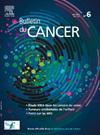High expression and regulatory mechanisms of ANGPT1 and HOXA3 in acute myeloid leukemia
IF 0.8
4区 医学
Q4 ONCOLOGY
引用次数: 0
Abstract
Objective
Acute Myeloid Leukemia (AML) is a type of leukemia characterized by the malignant clonal proliferation of hematopoietic stem cells in the bone marrow. This study aims to investigate the role of ANGPT1 and HOXA3 in the leukemia cell line KG-1a.
Methods
The expression patterns of ANGPT1 and HOXA3 in AML patients were determined by analyzing the TCGA database and clinical samples. Experiments were conducted using the KG-1a cell line, including flow cytometry and SA-β-Gal staining, to knock down ANGPT1 and HOXA3 and evaluate their functions.
Results
ANGPT1 and HOXA3 were found to be highly expressed in AML patients. Knocking down ANGPT1 and HOXA3 promoted apoptosis and senescence in KG-1a cells by inhibiting proliferation-related genes and upregulating apoptosis-related genes. There is a reciprocal regulatory relationship between ANGPT1 and HOXA3, forming a positive feedback loop. Treatment with ATRA downregulated the expression of HOXA3 and induced apoptosis in KG-1a cells, highlighting the importance of HOXA3 as a therapeutic target in AML.
Conclusion
ANGPT1 and HOXA3 are highly expressed in AML, and knocking them down can promote apoptosis and senescence in leukemia cells. They exhibit a mutual regulatory relationship, forming a positive feedback loop. These findings contribute to a better understanding of the functional roles and regulatory mechanisms of ANGPT1 and HOXA3, and provide new scientific evidence for the treatment and prognosis improvement of AML patients.
ANGPT1和HOXA3在急性髓性白血病中的高表达及其调控机制。
目的:急性髓系白血病(Acute Myeloid Leukemia, AML)是一种以骨髓造血干细胞恶性克隆增殖为特征的白血病。本研究旨在探讨ANGPT1和HOXA3在白血病细胞系KG-1a中的作用。方法:通过TCGA数据库和临床样本分析AML患者ANGPT1和HOXA3的表达模式。实验采用KG-1a细胞系,通过流式细胞术和SA-β-Gal染色检测ANGPT1和HOXA3的表达,并评价其功能。结果:AML患者中ANGPT1、HOXA3高表达。敲低ANGPT1和HOXA3通过抑制增殖相关基因和上调凋亡相关基因,促进KG-1a细胞凋亡和衰老。ANGPT1与HOXA3之间存在相互调节关系,形成正反馈回路。ATRA治疗可下调KG-1a细胞中HOXA3的表达并诱导凋亡,这突出了HOXA3作为AML治疗靶点的重要性。结论:ANGPT1和HOXA3在AML中高表达,敲除它们可促进白血病细胞凋亡和衰老。它们表现出一种相互调节的关系,形成一个正反馈循环。这些发现有助于更好地理解ANGPT1和HOXA3的功能作用和调控机制,为AML患者的治疗和预后改善提供新的科学依据。
本文章由计算机程序翻译,如有差异,请以英文原文为准。
求助全文
约1分钟内获得全文
求助全文
来源期刊

Bulletin Du Cancer
医学-肿瘤学
CiteScore
1.90
自引率
16.70%
发文量
224
审稿时长
37 days
期刊介绍:
Without doubt, the ''Bulletin du Cancer'' is the French language publication of reference in the field of cancerology. Official organ of the French Society of Cancer, this journal covers all the information available, whether in the form of original articles or review articles, but also clinical cases and letters to the editor, including various disciplines as onco-hematology, solids tumors, medical oncology, pharmacology, epidemiology, biology as well as fundamental research in cancerology. The journal proposes a clinical and therapeutic approach of high scientific standard and regular updates in knowledge are thus made possible. Articles can be submitted in French or English.
 求助内容:
求助内容: 应助结果提醒方式:
应助结果提醒方式:


